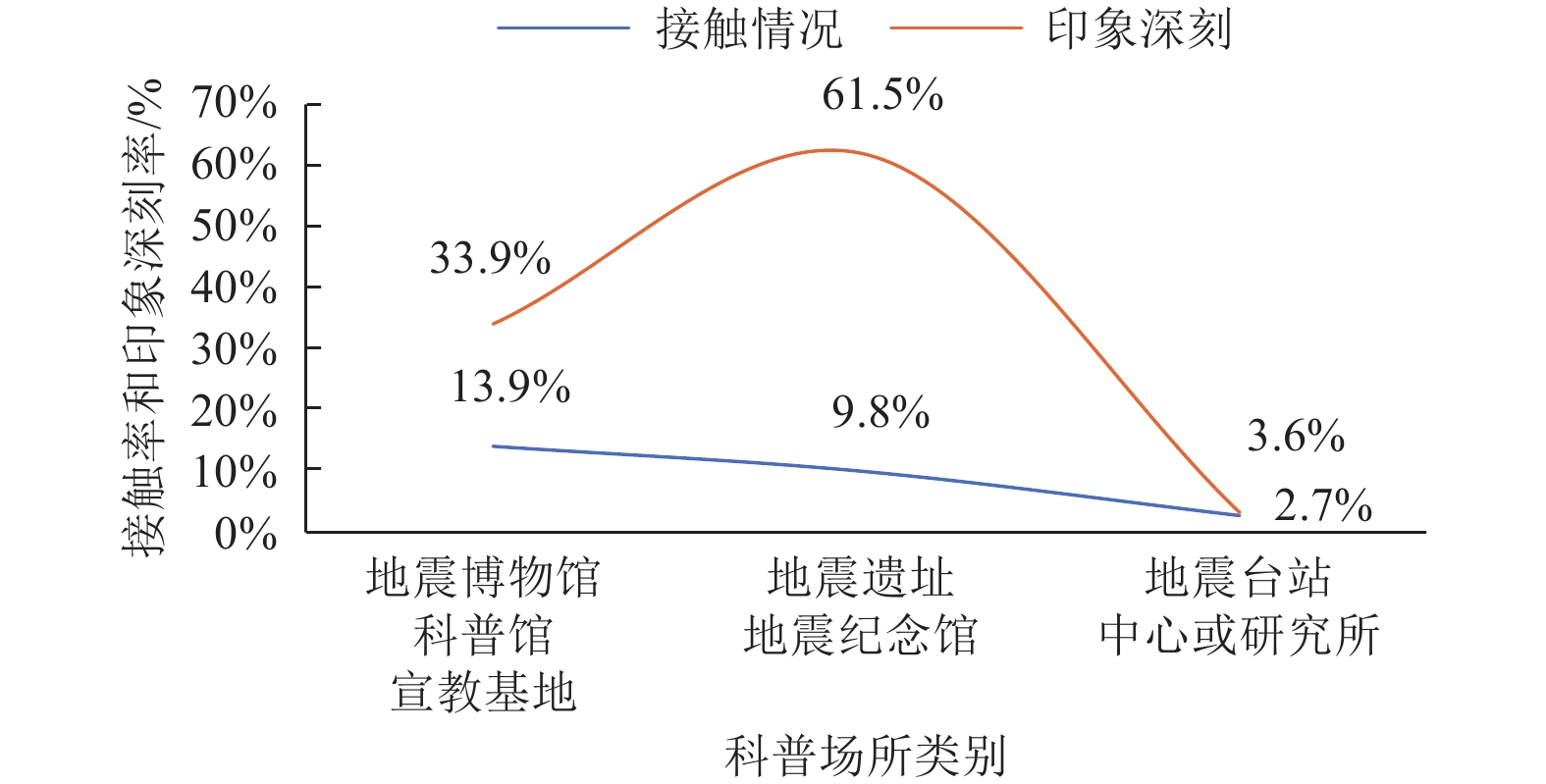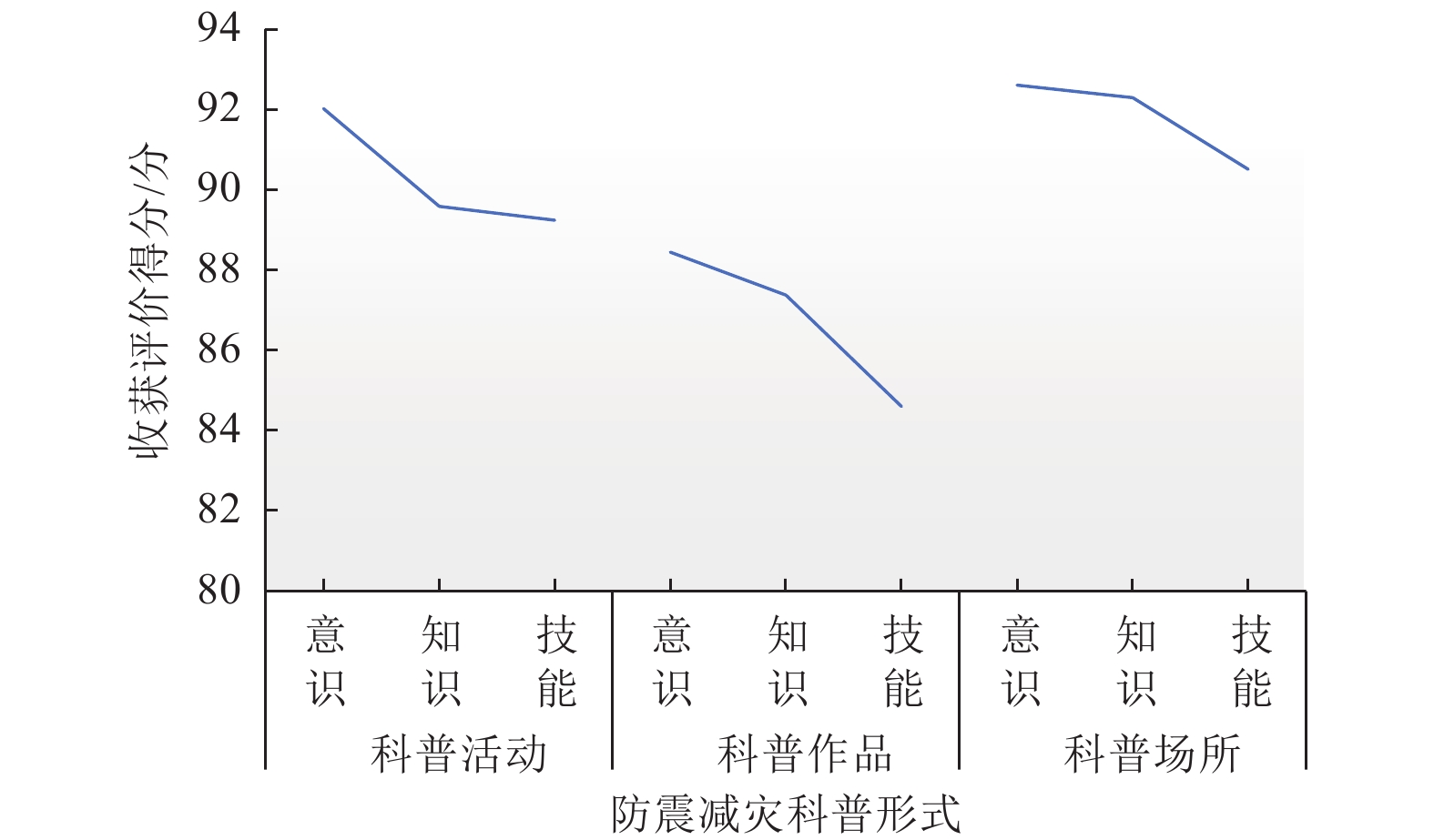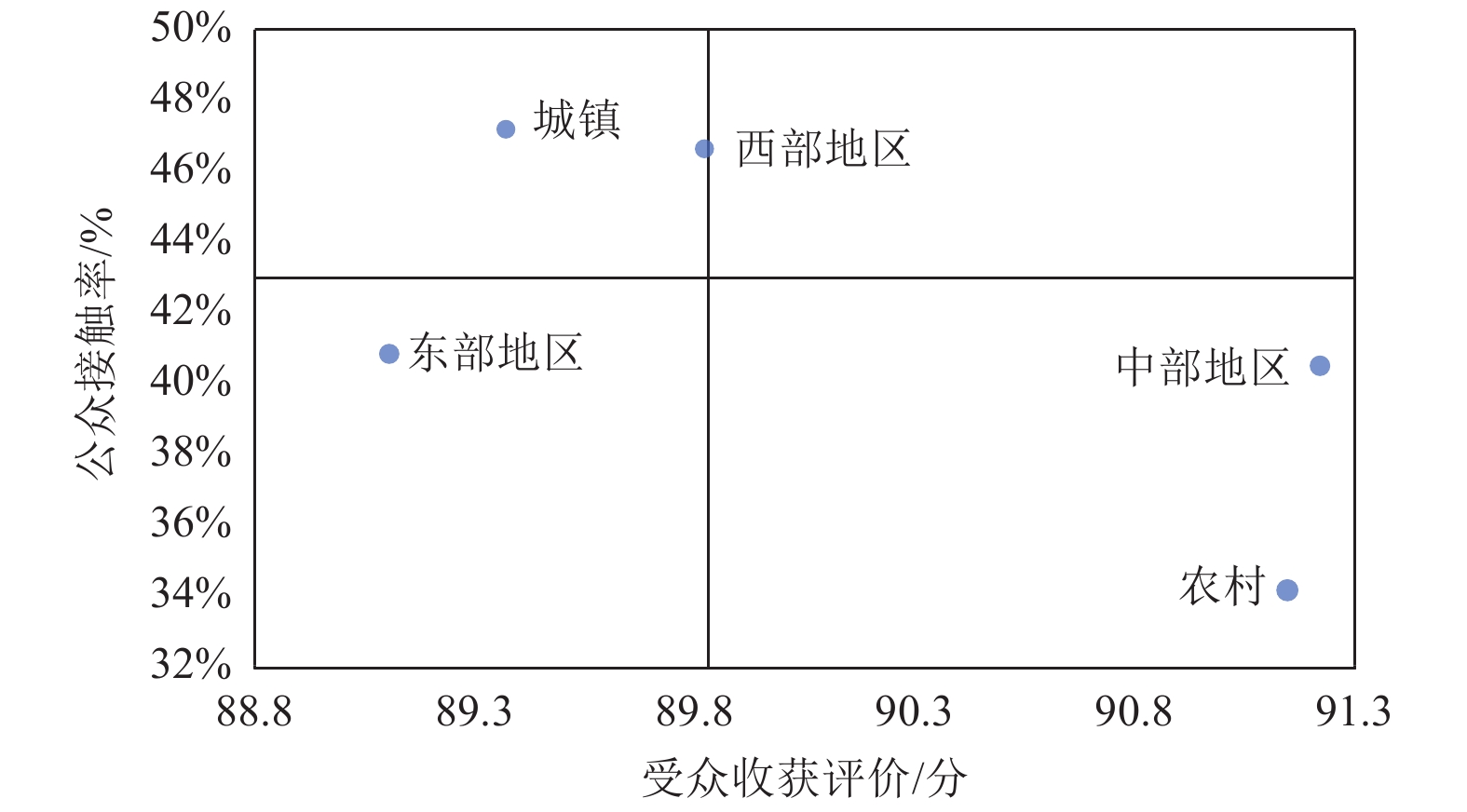Index Design and Result Analysis of the Earthquake Knowledge Demand and Popularization Satisfaction Survey
-
摘要: 本文针对2020年全国公众防震减灾科普满意度调查工作,设计了防震减灾科普公众接触率、受众收获评价、公众满意度和需求等指标,量化衡量防震减灾科普在公众中的触达现状、公众的收获评价、反馈评价和需求。调查结果显示,公众与防震减灾科普的接触较普遍,受众收获评价和满意度评价总体得分较高。防震减灾科普公众接触率在不同城乡、年龄、学历、职业等层面的群体差异较明显。科普活动的公众接触率相对较低,受众收获评价较高,公众对活动新颖性的满意度评价低于活动组织管理。科普作品的公众接触率最高,但受众收获评价较低,在促进公众技能提升方面具有明显短板,公众对作品形式新颖性的满意度评价低于内容通俗易懂性。科普场所的公众接触率最低,但受众收获评价最高,对公众知识、技能、意识的提升作用较好。公众对科普场所信息查找便利性的满意度较低,导致科普场所满意度评价低于科普活动和科普作品。分析表明,需重视公众需求和反馈,采取有针对性的措施进一步提升防震减灾科普效率。Abstract: In 2020, the China Earthquake Administration launched a nationwide sample survey on the public feedback of earthquake knowledge popularization. The survey has constructed a set of evaluation index system to quantify the public participation, satisfaction and needs of earthquake knowledge popularization. The results show that the public has close contact with earthquake knowledge popularization, and gives a relatively high evaluation to the participant’s gains and satisfaction. There are obvious differences in public participation between urban and rural areas, age, educational background, and occupation. The public participation ratio of earthquake knowledge popularization activities is relatively low, but the participant’s gains evaluation is high. The public is more satisfied with organization and management than novelty of the activities. Knowledge popularization works have the highest public participation ratio, but receive the lowest participant’s gains evaluation. They have obvious shortcomings in improving the public's skills. The public is more satisfied with easy-to-understand than novelty of the works. The public participation ratio of knowledge popularization venues is low, but the participant’s gains evaluation is the highest. They have a good effect on the promotion of public knowledge, skills, and awareness. The public satisfaction score of knowledge popularization venues is the lowest, because the public is not very satisfied with the convenience of finding their information. We need to pay attention to these demonds and feedback from the public, and take targeted measures to further improve the efficiency of earthquake knowledge popularization.
-
表 1 防震减灾科普公众接触率指标
Table 1. Index table for public participation ratio of earthquake knowledge popularization
指标名称 指标赋值与计算方法 防震减灾科普活动公众接触率 参加过至少1项防震减灾科普活动人数占全部有效样本的比例 防震减灾科普作品公众接触率 接触过至少1项防震减灾科普作品人数占全部有效样本的比例 防震减灾科普场所公众接触率 参观过至少1类防震减灾科普场所人数占全部有效样本的比例 表 2 防震减灾科普受众收获评价指标
Table 2. Index table for the participant’s gains evaluation of earthquake knowledge popularization
一级指标 二级指标 防震减灾科普活动受众收获评价 知识掌握度(1/3权重) 意识提高度(1/3权重) 技能掌握度(1/3权重) 防震减灾科普作品受众收获评价 知识掌握度(1/3权重) 意识提高度(1/3权重) 技能掌握度(1/3权重) 防震减灾科普场所受众收获评价 知识掌握度(1/3权重) 意识提高度(1/3权重) 技能掌握度(1/3权重) 表 3 防震减灾科普公众满意度测评三级指标
Table 3. Three-level index table for public satisfaction evaluation of earthquake knowledge popularization
一级指标 二级指标 三级指标
防震减灾科普
公众总体满意度防震减灾科普活动满意度
(1/3权重)组织管理有序性(1/3权重) 互动性(1/3权重) 形式新颖性(1/3权重) 防震减灾科普作品满意度
(1/3权重)形式新颖性(1/2权重) 内容通俗易懂性(1/2权重) 防震减灾科普场所满意度
(1/3权重)信息查找便利性(1/3权重) 内容清晰易懂性(1/3权重) 讲解风格吸引程度(1/3权重) 表 4 调查样本结构与总体一致性
Table 4. Consistency of survey sample structure and population
类别 样本量/个 样本占比/% 人口比例统计数据/% 与总体差值/% 性别 男 2 426 52.5 51.2 1.3 女 2 198 47.5 48.8 −1.3 城乡 城镇 3 113 67.3 63.9 −3.4 农村 1 511 32.7 36.1 3.4 年龄 16~24岁 695 15.0 8.0(20~24岁) 7.0 25~29岁 442 9.6 11.0 −1.4 30~34岁 658 14.2 11.0 3.2 35~39岁 510 11.0 9.7 1.3 40~44岁 527 11.4 9.9 1.5 45~49岁 378 8.2 12.1 −3.9 50~54岁 464 10.0 11.4 −1.4 55~59岁 530 11.5 8.3 3.2 60~64岁 219 4.7 8.0 −3.3 65~75岁 201 4.3 10.6(65~74岁) −6.3 -
[1] 国家统计局, 2019. 2019中国统计年鉴. 北京: 中国统计出版社.National Bureau of Statistics, 2019. 2019 China statistical yearbook. Beijing: China Statistics Press. (in Chinese) [2] 国家统计局, 2021a. 第七次全国人口普查公报(第四号)−人口性别构成情况. [2021-05-11]. http://www.stats.gov.cn/tjsj/tjgb/rkpcgb/qgrkpcgb/202106/t20210628_1818823.html. [3] 国家统计局, 2021b. 第七次全国人口普查公报(第七号)−城乡人口和流动人口情况. [2021-05-11]. http://www.stats.gov.cn/tjsj/tjgb/rkpcgb/qgrkpcgb/202106/t20210628_1818826.html. [4] 胡俊平, 石顺科, 2011. 我国城市社区科普的公众需求及满意度研究. 科普研究, 6(5): 18—26 doi: 10.3969/j.issn.1673-8357.2011.05.004Hu J. P. , Shi S. K. , 2011. A study on the citizen’s needs and satisfaction of science popularization in the urban community of China. Science Popularization, 6(5): 18—26. (in Chinese) doi: 10.3969/j.issn.1673-8357.2011.05.004 [5] 连尉平, 李玉梅, 刘培玄等, 2021.2020年全国公众防震减灾素养水平及主要特点研究. 灾害学, 36(2): 171—175 doi: 10.3969/j.issn.1000-811X.2021.02.030Lian W. P. , Li Y. M. , Liu P. X. , et al. , 2021. Research on Chinese residents’ literacy level of earthquake disaster mitigation in 2020 and its main characteristics. Journal of Catastrophology, 36(2): 171—175. (in Chinese) doi: 10.3969/j.issn.1000-811X.2021.02.030 [6] 刘武, 2009. 公共服务接受者满意度指数模型研究. 沈阳: 东北大学.Liu. W. , 2009. Research on the public services cumtomer satisfaction index models. Shenyang: Northeastern University. (in Chinese) [7] 吕维霞, 刘彦波, 陈晔, 2009. 顾客感知行政服务质量管理. 兰州大学学报(社会科学版), 37(1): 100—105 doi: 10.3969/j.issn.1000-2804.2009.01.016Lü W. X. , Liu Y. B. , Chen Y. , 2009. Management of customers’ perception to the administrative service quality. Journal of Lanzhou University (Social Sciences), 37(1): 100—105. (in Chinese) doi: 10.3969/j.issn.1000-2804.2009.01.016 [8] 孟洁, 方妍, 杨青青, 2021. 基于顾客满意度指数模型的科普场馆观众满意度测评——以北京天文馆为例. 科学教育与博物馆, 7(1): 6—13Meng J. , Fang Y. , Yang Q. Q. , 2021. Analysis of visitors' satisfaction in science museums by using customer satisfaction index: take Beijing Planetarium as an example. Science Education and Museums, 7(1): 6—13. (in Chinese) [9] 彭云, 马亮, 2020. “放管服”改革视域下的政务服务“好差评”制度——中国省级政府的比较研究. 行政论坛, 27(6): 51—58 doi: 10.3969/j.issn.1005-460X.2020.06.008Peng Y. , Ma L. , 2020. The "good & bad evaluation" institution from the perspective of the delegation, deregulation and service innovation reform——an empirical study of Chinese provincial governments. Administrative Tribune, 27(6): 51—58. (in Chinese) doi: 10.3969/j.issn.1005-460X.2020.06.008 [10] 单修政, 高文长, 2013. 论地震科普宣传工作在防震减灾事业中的意义. 高原地震, 25(1): 53—58 doi: 10.3969/j.issn.1005-586X.2013.01.011Shan X. Z. , Gao W. C. , 2013. On the significance of the earthquake science advocacy work in the cause of earthquake disaster reduction. Plateau Earthquake Research, 25(1): 53—58. (in Chinese) doi: 10.3969/j.issn.1005-586X.2013.01.011 [11] 盛明科, 刘贵忠, 2006. 政府服务的公众满意度测评模型与方法研究. 湖南社会科学, (6): 36—40. doi: 10.3969/j.issn.1009-5675.2006.06.009 [12] 苏桂武, 马宗晋, 王若嘉等, 2008. 汶川地震灾区民众认知与响应地震灾害的特点及其减灾宣教意义——以四川省德阳市为例. 地震地质, 30(4): 877—894 doi: 10.3969/j.issn.0253-4967.2008.04.005Su G. W. , Ma Z. J. , Wang R. J. , et al. , 2008. General Features and their disaster-reduction education implications of the earthquake disaster cognition and responses of the social public in MS 8.0 Wenchuan earthquake-hit area: a case study from Deyang prefecture-level city, Sichuan Province. Seismology and Geology, 30(4): 877—894. (in Chinese) doi: 10.3969/j.issn.0253-4967.2008.04.005 [13] 王萍, 闫丽莉, 庞群英等, 2020. 天津市公众地震科普认知与需求调查. 震灾防御技术, 15(3): 601—608 doi: 10.11899/zzfy20200314Wang P. , Yan L. L. , Pang Q. Y. , et al. , 2020. Analysis of public cognition and demand of earthquake science popularization and suggestions - based on Tianjin public questionnaire survey. Technology for Earthquake Disaster Prevention, 15(3): 601—608. (in Chinese) doi: 10.11899/zzfy20200314 [14] 赵兰兰, 2018. 城镇社区居民科普需求及满意度调研——以北京市为例. 科普研究, 13(5): 40—49Zhao L. L. , 2018. A research on residents’ needs and satisfaction for science popularization in urban community: take Beijing as an example. Studies on Science Popularization, 13(5): 40—49. (in Chinese) [15] 邹文卫, 洪银屏, 翁武明等, 2011. 北京市社会公众防震减灾科普认知、需求调查研究. 国际地震动态, (6): 15—31 doi: 10.3969/j.issn.0235-4975.2011.06.005Zou W. W. , Hong Y. P. , Weng W. M. , et al. , 2011. Investigation of public awareness and demand on scientific knowledge popularization of earthquake disaster mitigation in Beijing. Recent Developments in World Seismology, (6): 15—31. (in Chinese) doi: 10.3969/j.issn.0235-4975.2011.06.005 -




 下载:
下载:






